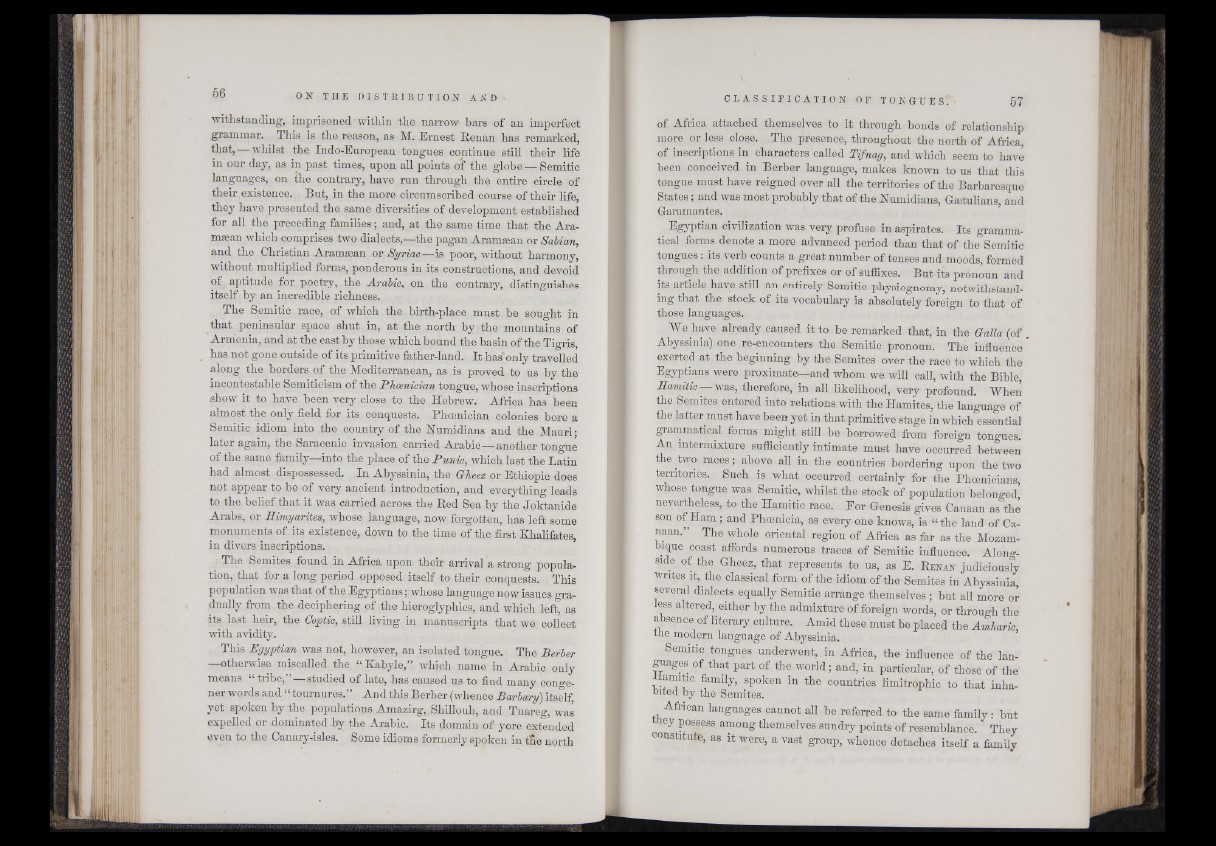
withstanding, imprisoned within the narrow bars of an imperfect
grammar. This is the reason, as M. Ernest Renan has remarked,
that, whilst the Indo-European tongues continue still their life
in our day, as in past times, upon all points of the globe — Semitic
languages, on the contrary, have run through the entire circle of
their existence. But, in the more circumscribed course of their life,
they have presented the same diversities of development established
for all the preceding families; and, at the same time that the Aramaean
which comprises two dialects,-—the pagan Aramaean or Sabian,
and the Christian Aramaean or Syriac—is poor, without harmony,
without multiplied forms, ponderous in its constructions, and devoid
of aptitude for poetry, the Arabic, on the contrary, distinguishes
itself by an incredible richness.
The Semitic race, of which the birth-place must he sought in
that peninsular space shut in, at the north by the mountains of
Armenia, and at the east by those which hound the basin of the Tigris,
has not gone outside of its primitive father-land. It has only travelled
along the borders of the Mediterranean, as is proved to us by the
incontestable Semiticism of the Phoenician tongue, whose inscriptions
show it to have been very close to the Hebrew. Africa has been
almost the only field for its conquests. Phoenician coionies bore a
Semitic idiom into the country Of the Bumidians and the Mauri;
later again, the Saracenic invasion carried Au-abic—another tongue
of the same family—into the place of the Punic, which last the Latin
had almost dispossessed. In Abyssinia, the Gtheez or Ethiopic does
not appear to he of very ancient introduction, and everything leads
to the belief that it was carried across the Red Sea by the Joktanide
Arabs, or Eimyarites, whose language, mow forgotten, has left some
monuments of its existence, down to the time of the first Khalifates
in divers inscriptions.
The Semites found in Attica upon their arrival a strong population,
that for a long period opposed itself to their conquests. This
population Was that of the Egyptians; whose language now issues gradually
from the deciphering of the hieroglyphics, and which left, as
its last heir, the Coptic, still living in manuscripts that we collect
with avidity.
This Egyptian was not, however, an isolated tongue. The Berber
—otherwise miscalled the “ Kabyle,” which name in Arabic only
means “ tribe,”—studied of late, has caused us to find many congener
words and “ tournures.” And this Berber (whence Barbary) itself,
yet spoken by the populations Amazirg,.Shillouh, and Tuareg, was
expelled or dominated by the Arabic. Its domain of yore extended
even to the Canaiy-isles. Some idioms formerly spoken in the north
of Africa attached themselves to it through bonds of relationship
more or less close. The presence, throughout the north of Attica,
of inscriptions in characters called Ti/nag, and which seem to have
been conceived in Berber language, makes known to us that this
tongue must have reigned over all the territories of the Barbaresque
States; and was most probably that of the Numidians, Gsetulians, and
Garamantes.
Egyptian civilization was very profuse in aspirates. Its grammatical
forms denote a more advanced period than that of the Semitic
tongues: its verb counts a great number of tenses and moods, formed
through the addition of prefixes or of suffixes. But its pronoun and
its article have still an entirely Semitic physiognomy, notwithstanding
that the stock of its vocabulary is absolutely foreign to that of
those languages.
We have already caused it to be remarked that, in the G-alla (of .
Abyssinia) one re-encounters the Semitic pronoun. The influence"
exerted at the beginning by the Semites over the race to which the
Egyptians were proximate—and whom we will call, with the Bible,
Eamitic — was, therefore, in all likelihood, veiy profound. When
the Semites entered into relations with the Hamites, the language of
the latter must have been yet in that primitive stage in which essentia]
grammatical forms might still be borrowed from foreign tongues.
An intermixture sufficiently intimate must have occurred between
the two races; above all in the countries bordering upon the two
territories. Such is what occurred certainly for the Phoenicians,
whose tongue was Semitic, whilst the stock of population belonged,
nevertheless, do the Hamitic race. For Genesis gives Canaan as the
son of Ham ; and Phoenicia, as every one knows, is “ the land of Canaan.”
The whole oriental region of Africa as far as the Mozambique
coast affords numerous traces of Semitic influence. Alongside
of the Gheez, that represents to us, as E. R enan judiciously
writes it, the classical form of the idiom of the Semites in Abyssinia,
several dialects equally Semitic arrange themselves ; but all more or
less altered, either by the admixture of foreign words, or through the
absence of literary culture. Amid these must be placed the Amharic,
tne modern language of Abyssinia.
Semitic tongues underwent, in Africa, the influence of the languages
of that part of the world; and, in particular, of those of the
Jlamittc family, spoken in the countries limitrophic to that inhabited
by the Semites. •
African languages cannot, all he referred to the same family: but
ney possess among themselves sundry points of resemblance. They
constitute, as it were, a vast group, whence detaches itself a family